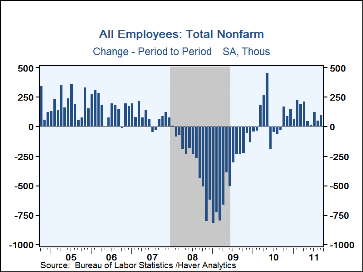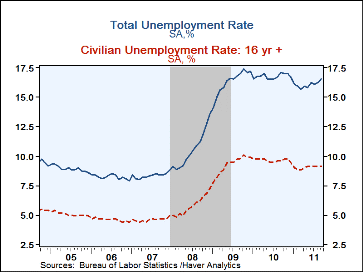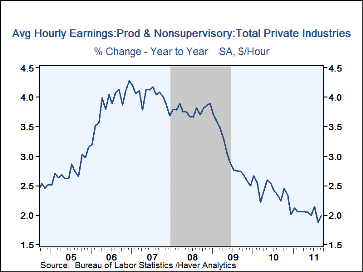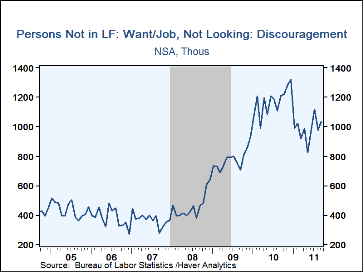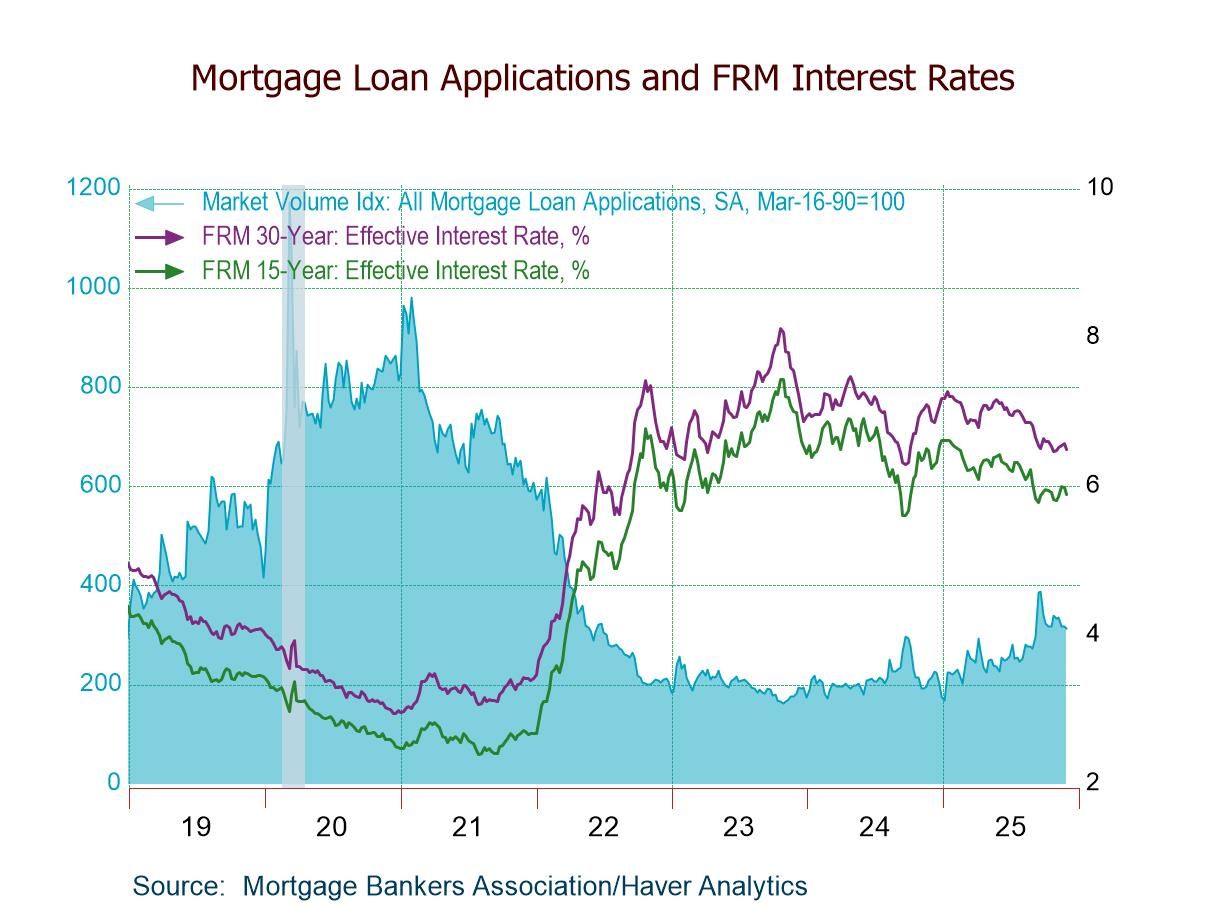 Global| Oct 07 2011
Global| Oct 07 2011U.S. Nonfarm Payrolls' Modest Rise Aided By Strike's End
by:Tom Moeller
|in:Economy in Brief
Summary
Last month's reading for jobs growth was better, but not great. Nonfarm payrolls rose 103,000 last month after August and July increases which were upwardly revised. Several factors, however, discount any notion of broad-based labor [...]
Last month's reading for jobs growth was better, but not great. Nonfarm payrolls rose 103,000 last month after August and July increases which were upwardly revised. Several factors, however, discount any notion of broad-based labor market improvement. 1) The latest figure was boosted by 45,000 telecom strikers returning to work. 2) Excluding strikers, payrolls were no better than advertised in earlier labor market reports for September. 3) In percentage terms, the 0.1% September increase was hardly changed from the monthly increases over the last year. 4) The gain brought with it no decline in the unemployment rate, still at 9.1%. 5) Upward revisions to earlier months' figures were small and confined mostly to government payrolls. The Consensus estimate for September payrolls was for +56,000.
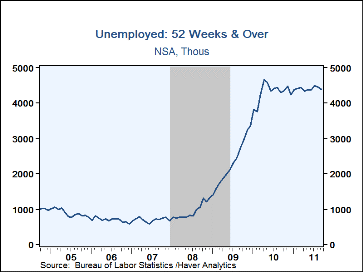 Nonfarm payrolls rose 103,000 last month following gains of
57,000 during August and 127,000 during July, upwardly
revised from no-change and 85,000, respectively. The latest figure reflected the
return to work of strikers at Verizon. Factory sector payrolls fell
another 13,000 reflecting broad-based industry weakness. Construction employment
rose a moderate 26,000 leaving the y/y change at 0.7%. In the private service sector,
payrolls rose 119,000 boosted by returning strikers. Elsewhere, gains were
moderate. To the upside,
professional & business service employment rose an improved 48,000
(3.4%
y/y), jobs in health care & social assistance gained 40,800 (2.2%
y/y) and retail trade employment rose 13,600 (1.1%). Temporary help jobs rose
19,400 (8.4% y/y). On the weak side were leisure & hospitality jobs
which fell 4,000 (+0.9% y/y) and financial activities where employment
slipped 8,000 (-2.2% y/y). Government employment fell 34,000 (-1.3% y/y)
with declines across sectors.
Nonfarm payrolls rose 103,000 last month following gains of
57,000 during August and 127,000 during July, upwardly
revised from no-change and 85,000, respectively. The latest figure reflected the
return to work of strikers at Verizon. Factory sector payrolls fell
another 13,000 reflecting broad-based industry weakness. Construction employment
rose a moderate 26,000 leaving the y/y change at 0.7%. In the private service sector,
payrolls rose 119,000 boosted by returning strikers. Elsewhere, gains were
moderate. To the upside,
professional & business service employment rose an improved 48,000
(3.4%
y/y), jobs in health care & social assistance gained 40,800 (2.2%
y/y) and retail trade employment rose 13,600 (1.1%). Temporary help jobs rose
19,400 (8.4% y/y). On the weak side were leisure & hospitality jobs
which fell 4,000 (+0.9% y/y) and financial activities where employment
slipped 8,000 (-2.2% y/y). Government employment fell 34,000 (-1.3% y/y)
with declines across sectors.
Elsewhere in the establishment survey, average weekly hours worked recovered to 34.3 for September. Along with the job gains, this left the Q3 index of aggregate hours worked & payrolls unchanged from Q2, following that quarter's 0.9% rise.
The modest jobs gains were accompanied by a 0.2% (2.0% y/y) increase in average hourly earnings. The gain followed an upwardly revised reading of no-change in August but the y/y gain of 2.0% was half that in 2007. Earnings in the service sector rose 0.2% m/m (2.0% y/y) and factory sector earnings were unchanged (+1.4% y/y).
From the household survey, the unemployment rate held at an expected 9.1% for the fourth month in the last five. That reflected a 398,000 increase (0.5% y/y) in employment and a 423,000 rise (-0.1% y/y) in the labor force. The overall unemployment rate, including involuntarily part-time workers as well as those marginally attached, rose to 16.5%, its highest level this year.
The labor force participation rate slipped m/m to 52.5%. The number out of the labor force but want a job fell 14.2% y/y. The number of workers unemployed for 52 weeks or longer slipped m/m to 4.386M (+2.3% y/y) but remained near its high. The average duration of unemployment reached a new high of 40.5 weeks. The breadth of employment increase over the last three months fell to 56.2%, its lowest in twelve months.
The figures referenced above are available in Haver's USECON database. Additional detail can be found in the LABOR and in the EMPL databases. The expectation figures are from Action Economics and are in the AS1REPNA database.
What Is The New Normal Unemployment Rate? from the Federal Reserve Bank of San Francisco is available here.
| Employment: (M/M Chg., 000s) | Sep | Aug | Jul | Y/Y | 2010 | 2009 | 2008 |
|---|---|---|---|---|---|---|---|
| Payroll Employment | 103 | 57 | 127 | 1.1% | -0.7% | -4.4% | -0.6% |
| Previous | -- | 0 | 85 | -- | -- | -- | -- |
| Manufacturing | -13 | -4 | 34 | 1.7 | -2.7 | -11.6 | -3.4 |
| Construction | 26 | -7 | 10 | 0.7 | -8.1 | -16.0 | -6.1 |
| Private Service Producing | 119 | 51 | 120 | 1.6 | -0.1 | -3.5 | -0.2 |
| Government | -34 | 15 | -46 | -1.3 | -0.3 | 0.3 | 1.3 |
| Average Weekly Hours | 34.3 | 34.2 | 34.3 | 34.2 (Sep.'10) |
34.1 | 33.9 | 34.5 |
| Average Hourly Earnings (%) | 0.2 | 0.0 | 0.3 | 2.0 | 2.4 | 3.0 | 3.8 |
| Unemployment Rate(%) | 9.1 | 9.1 | 9.1 | 9.6 (Sep.'10) |
9.6 | 9.3 | 5.8 |
Tom Moeller
AuthorMore in Author Profile »Prior to joining Haver Analytics in 2000, Mr. Moeller worked as the Economist at Chancellor Capital Management from 1985 to 1999. There, he developed comprehensive economic forecasts and interpreted economic data for equity and fixed income portfolio managers. Also at Chancellor, Mr. Moeller worked as an equity analyst and was responsible for researching and rating companies in the economically sensitive automobile and housing industries for investment in Chancellor’s equity portfolio. Prior to joining Chancellor, Mr. Moeller was an Economist at Citibank from 1979 to 1984. He also analyzed pricing behavior in the metals industry for the Council on Wage and Price Stability in Washington, D.C. In 1999, Mr. Moeller received the award for most accurate forecast from the Forecasters' Club of New York. From 1990 to 1992 he was President of the New York Association for Business Economists. Mr. Moeller earned an M.B.A. in Finance from Fordham University, where he graduated in 1987. He holds a Bachelor of Arts in Economics from George Washington University.


